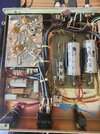Is there a way to make the 20,40 band on a Palomar 300A have a lower input as it does on the 10-meter band with the input and output trimmers
I was tunning on 20 meters today but my Yaesu ft-890 kept flicking a high SWR light I turned the auto tuner on it kind of helped but made the tuner get hot quickly being SWR was past 3.5 I turned it off and put my MFJ auto tuner in line radio show 1.2 I want to make it work with out having to use extra equipment in line if all possible
I was tunning on 20 meters today but my Yaesu ft-890 kept flicking a high SWR light I turned the auto tuner on it kind of helped but made the tuner get hot quickly being SWR was past 3.5 I turned it off and put my MFJ auto tuner in line radio show 1.2 I want to make it work with out having to use extra equipment in line if all possible


